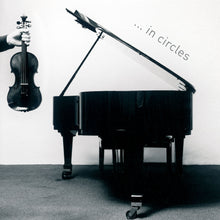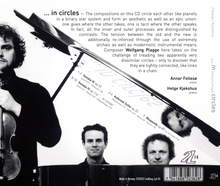These compositions circle each other like planets in a binary star system and form an aesthetic as well as an epic union: one gives where the other takes, one is tacit where the other speaks. In fact, all the inner and outer processes are distinguished by contrasts. The tension between the old and the new is additionally reinforced through the use of extremely archaic as well as modernistic instrumental means. Composer Wolfgang Plagge here takes on the challenge of treading two apparently very dissimilar circles – only to discover that they are tightly connected, like links in a chain.
The two sonatas for violin and piano – op. 93 and op. 116 – are in many ways mirror images of one another. Seen from the outside, both consist of one horizontal and one vertical time axis, one of them assertive and quick, the other introverted and gentle. Sonata no. III op. 93 (1997) begins impetuously and restlessly, but eventually flows into a quiet and stately final movement. Sonata no. IV op. 116 (2001) has an altogether contrary pattern: a static, probing introduction ultimately leads into an explosive and extroverted conclusion. Also on a deeper level the two works circle one another like planets in a binary star system and form an aesthetic as well as an epic union: one gives where the other takes, one is tacit where the other speaks. In fact, all the inner and outer processes are distinguished by binary contrasts – strong-weak, fast-slow, light-dark, aggression-melancholy, sorrow-joy. The two sonatas can well be understood as two-faced extremes, or poles with opposing charges, but I rather conceive of them as two half circles that meet one another at their upper and lower points.
Precisely this aspect of bipolarity on all levels has captivated me in these two works, and my fascination for the musical history of the Middle Ages has furthermore left profound marks on sonata no. IV in the form of a Gregorian sequence – an old Norwegian version of Thomas Aquinas’ hymn "Lauda Sion" comprises one of the work's two primary elements. The tension between the old and the new is additionally reinforced through the use of extremely archaic (open fifths, violin playing without vibrato) as well as modernistic (quarter tones, aleatoric elements) instrumental means. As a composer I therefore took on the challenge of treading two apparently very dissimilar circles – only to discover that they are tightly connected, like links in a chain.
Asteroid Suite op. 33 (1987) is a humoristic treatment of mythical figures. Discovering ever new heavenly bodies within and outside of our solar system, astronomers have from the earliest days often given these "new" planets, planetoids and constellations beautiful and imaginative names from the world of mythology. As a result, major parts of the Greek and Roman pantheon are scattered across the heavens in the form of stars such as Mars, Venus and Orion. The four movements of Asteroid Suite are thus named after decidedly real planetoids, as well as four Greco-Roman mythological figures: Melpomene is the muse of tragic poetry, Ceres the Roman goddess of harvest, Vesta the goddess of the hearth and guardian of society, as well as a symbol of purity, and Hector a fearless and bold Grecian warrior, the son of Priam, renowned as the man who lost the duel against the half-god Achilles.
My point of departure for the depictions of the four asteroids lies therefore within their Greco-Roman personifications, and is meant more as caricature rather than characterization. The suite is a good-natured and slightly ironic comment upon Gustav Holst’s very illustrative orchestral suite "The Planets". The 3. movement, "Vesta", furthermore includes a musical salute to the great Polish composer Witold Lutoslawski by way of a short quote from his brilliant "Dance Preludes".
Rhapsody op. 89 (1996) is a work for solo violin in divertimento style, full of technical challenges for the violinist. Similar to the two sonatas, the Rhapsody displays a pronounced dualism, and the music changes rapidly between expressive and technical extremes. This is one of the few works of mine that incorporate distinctly "Norwegian" musical elements. — Wolfgang Plagge, 2003
|
Album title
|
Wolfgang Plagge: ... in circles |
|---|---|
|
Performer
|
Annar Follesø, violin |
|
Producer
|
Wolfgang Plagge, Morten Lindberg |
|
Catalogue #
|
2L-014-CD |
|
EAN13
|
7041888503828 |
|
ISRC-code
|
NOMPP0303001-010 |
|
Disc 1
|
CD (Stereo RedBook PCM) |
| Disc 2 | |
|
Release date
|
April 2003 |
|
Recording date
|
January 2003 |
|
Location
|
Sofienberg Church, Norway |
|
Original source
|
44.1kHz/16bit |




